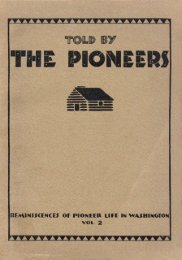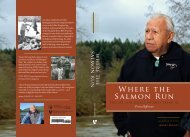- Page 2 and 3:
SLADE GORTON A HAlf Century in Poli
- Page 4:
For Sally and Patsy
- Page 7 and 8:
28. Who Gives a Hoot? 253 29. Back
- Page 9 and 10:
2 slade gorton: a half century in p
- Page 11 and 12:
4 sLAde goRton: A hALf centuRy in p
- Page 13 and 14:
6 sLAde goRton: A hALf centuRy in p
- Page 15 and 16:
8 sLAde goRton: A hALf centuRy in p
- Page 17 and 18:
10 sLAde goRton: A hALf centuRy in
- Page 19 and 20:
12 sLAde goRton: A hALf centuRy in
- Page 21 and 22:
14 sLAde goRton: A hALf centuRy in
- Page 23 and 24:
16 sLAde goRton: A hALf centuRy in
- Page 25 and 26:
18 sLAde goRton: A hALf centuRy in
- Page 27 and 28:
20 sLAde goRton: A hALf centuRy in
- Page 29 and 30:
2 | Dumb and Dumped SoMe iMAgine sL
- Page 31 and 32:
24 sLAde goRton: A hALf centuRy in
- Page 33 and 34:
26 sLAde goRton: A hALf centuRy in
- Page 35 and 36:
3 | The Change Agents wAs A BRAnd-n
- Page 37 and 38:
30 sLAde goRton: A hALf centuRy in
- Page 39 and 40:
32 sLAde goRton: A hALf centuRy in
- Page 41 and 42:
34 slade gorton: a half century in
- Page 43 and 44:
4 | The Freshman FRoM dAy one, RepR
- Page 45 and 46:
38 sLAde goRton: A hALf centuRy in
- Page 47 and 48:
40 sLAde goRton: A hALf centuRy in
- Page 49 and 50:
42 sLAde goRton: A hALf centuRy in
- Page 51 and 52:
44 sLAde goRton: A hALf centuRy in
- Page 53 and 54:
46 sLAde goRton: A hALf centuRy in
- Page 55 and 56:
48 sLAde goRton: A hALf centuRy in
- Page 57 and 58:
50 sLAde goRton: A hALf centuRy in
- Page 59 and 60:
52 sLAde goRton: A hALf centuRy in
- Page 61 and 62:
54 sLAde goRton: A hALf centuRy in
- Page 63 and 64:
56 sLAde goRton: A hALf centuRy in
- Page 65 and 66:
58 sLAde goRton: A hALf centuRy in
- Page 67 and 68:
60 sLAde goRton: A hALf centuRy in
- Page 69 and 70:
62 sLAde goRton: A hALf centuRy in
- Page 71 and 72:
64 sLAde goRton: A hALf centuRy in
- Page 73 and 74:
66 sLAde goRton: A hALf centuRy in
- Page 75 and 76:
68 sLAde goRton: A hALf centuRy in
- Page 77 and 78:
70 sLAde goRton: A hALf centuRy in
- Page 79 and 80:
72 sLAde goRton: A hALf centuRy in
- Page 81 and 82:
74 slade gorton: a half century in
- Page 83 and 84:
76 sLAde goRton: A hALf centuRy in
- Page 85 and 86:
78 sLAde goRton: A hALf centuRy in
- Page 87 and 88:
10 | General Gorton “Why don’t
- Page 89 and 90:
82 sLAde goRton: A hALf centuRy in
- Page 91 and 92:
84 sLAde goRton: A hALf centuRy in
- Page 93 and 94:
86 sLAde goRton: A hALf centuRy in
- Page 95 and 96:
88 sLAde goRton: A hALf centuRy in
- Page 97 and 98:
90 sLAde goRton: A hALf centuRy in
- Page 99 and 100:
92 sLAde goRton: A hALf centuRy in
- Page 101 and 102:
94 sLAde goRton: A hALf centuRy in
- Page 103 and 104:
11 | Unhappy Days EXuding confidenc
- Page 105 and 106:
98 sLAde goRton: A hALf centuRy in
- Page 107 and 108:
100 sLAde goRton: A hALf centuRy in
- Page 109 and 110:
102 sLAde goRton: A hALf centuRy in
- Page 111 and 112:
104 sLAde goRton: A hALf centuRy in
- Page 113 and 114:
106 sLAde goRton: A hALf centuRy in
- Page 115 and 116:
12 | Riding With History The pARKin
- Page 117 and 118:
110 sLAde goRton: A hALf centuRy in
- Page 119 and 120:
112 sLAde goRton: A hALf centuRy in
- Page 121 and 122:
13 | Gorton Agonistes BecKy goRton
- Page 123 and 124:
116 sLAde goRton: A hALf centuRy in
- Page 125 and 126:
118 sLAde goRton: A hALf centuRy in
- Page 127 and 128:
14 | The Jolt from Boldt MoRning dA
- Page 129 and 130:
122 sLAde goRton: A hALf centuRy in
- Page 131 and 132:
124 sLAde goRton: A hALf centuRy in
- Page 133 and 134:
126 sLAde goRton: A hALf centuRy in
- Page 135 and 136:
128 sLAde goRton: A hALf centuRy in
- Page 137 and 138:
130 sLAde goRton: A hALf centuRy in
- Page 139 and 140:
132 sLAde goRton: A hALf centuRy in
- Page 141 and 142:
15 | Designated Hitters One of geoR
- Page 143 and 144:
136 sLAde goRton: A hALf centuRy in
- Page 145 and 146:
138 sLAde goRton: A hALf centuRy in
- Page 147 and 148:
140 sLAde goRton: A hALf centuRy in
- Page 149 and 150:
142 sLAde goRton: A hALf centuRy in
- Page 151 and 152:
144 sLAde goRton: A hALf centuRy in
- Page 153 and 154:
146 sLAde goRton: A hALf centuRy in
- Page 155 and 156:
148 sLAde goRton: A hALf centuRy in
- Page 157 and 158:
17 | A Gold Watch for Maggie Mount
- Page 159 and 160:
152 sLAde goRton: A hALf centuRy in
- Page 161 and 162:
A “Next Great Senator!” flier f
- Page 163 and 164:
156 sLAde goRton: A hALf centuRy in
- Page 165 and 166:
158 sLAde goRton: A hALf centuRy in
- Page 167 and 168:
160 sLAde goRton: A hALf centuRy in
- Page 169 and 170:
18 | The Giant Killers The gReAt co
- Page 171 and 172:
164 sLAde goRton: A hALf centuRy in
- Page 173 and 174:
166 sLAde goRton: A hALf centuRy in
- Page 175 and 176:
168 sLAde goRton: A hALf centuRy in
- Page 177 and 178:
170 sLAde goRton: A hALf centuRy in
- Page 179 and 180:
172 sLAde goRton: A hALf centuRy in
- Page 181 and 182:
174 sLAde goRton: A hALf centuRy in
- Page 183 and 184:
176 sLAde goRton: A hALf centuRy in
- Page 185 and 186:
178 sLAde goRton: A hALf centuRy in
- Page 187 and 188:
20 | Ship Shape GoRton descRiBed hi
- Page 189 and 190:
182 sLAde goRton: A hALf centuRy in
- Page 191 and 192:
184 sLAde goRton: A hALf centuRy in
- Page 193 and 194:
186 sLAde goRton: A hALf centuRy in
- Page 195 and 196:
188 sLAde goRton: A hALf centuRy in
- Page 197 and 198:
190 sLAde goRton: A hALf centuRy in
- Page 199 and 200:
192 sLAde goRton: A hALf centuRy in
- Page 201 and 202:
194 sLAde goRton: A hALf centuRy in
- Page 203 and 204:
196 sLAde goRton: A hALf centuRy in
- Page 205 and 206:
22 | Déjà vu All Over Again EXit
- Page 207 and 208:
200 sLAde goRton: A hALf centuRy in
- Page 209 and 210: 202 sLAde goRton: A hALf centuRy in
- Page 211 and 212: 204 sLAde goRton: A hALf centuRy in
- Page 213 and 214: 206 sLAde goRton: A hALf centuRy in
- Page 215 and 216: 208 sLAde goRton: A hALf centuRy in
- Page 217 and 218: 210 sLAde goRton: A hALf centuRy in
- Page 219 and 220: 212 sLAde goRton: A hALf centuRy in
- Page 221 and 222: 25 | Trick or Treat The goRton cAMp
- Page 223 and 224: 216 sLAde goRton: A hALf centuRy in
- Page 225 and 226: 218 sLAde goRton: A hALf centuRy in
- Page 227 and 228: 220 sLAde goRton: A hALf centuRy in
- Page 229 and 230: 222 sLAde goRton: A hALf centuRy in
- Page 231 and 232: 224 sLAde goRton: A hALf centuRy in
- Page 233 and 234: 226 sLAde goRton: A hALf centuRy in
- Page 235 and 236: 26 | Post-mortems If victoRy hAs A
- Page 237 and 238: 230 sLAde goRton: A hALf centuRy in
- Page 239 and 240: 232 sLAde goRton: A hALf centuRy in
- Page 241 and 242: 234 sLAde goRton: A hALf centuRy in
- Page 243 and 244: 236 sLAde goRton: A hALf centuRy in
- Page 245 and 246: 238 sLAde goRton: A hALf centuRy in
- Page 247 and 248: 240 sLAde goRton: A hALf centuRy in
- Page 249 and 250: 242 sLAde goRton: A hALf centuRy in
- Page 251 and 252: 244 sLAde goRton: A hALf centuRy in
- Page 253 and 254: 246 sLAde goRton: A hALf centuRy in
- Page 255 and 256: 248 sLAde goRton: A hALf centuRy in
- Page 257 and 258: 250 sLAde goRton: A hALf centuRy in
- Page 259: 252 sLAde goRton: A hALf centuRy in
- Page 263 and 264: 256 sLAde goRton: A hALf centuRy in
- Page 265 and 266: 258 sLAde goRton: A hALf centuRy in
- Page 267 and 268: 260 sLAde goRton: A hALf centuRy in
- Page 269 and 270: 262 sLAde goRton: A hALf centuRy in
- Page 271 and 272: 264 sLAde goRton: A hALf centuRy in
- Page 273 and 274: 266 sLAde goRton: A hALf centuRy in
- Page 275 and 276: 29 | Back at Bat “Baseball, it is
- Page 277 and 278: 270 sLAde goRton: A hALf centuRy in
- Page 279 and 280: 272 sLAde goRton: A hALf centuRy in
- Page 281 and 282: 30 | New Friends and Old Enemies To
- Page 283 and 284: 276 sLAde goRton: A hALf centuRy in
- Page 285 and 286: 278 sLAde goRton: A hALf centuRy in
- Page 287 and 288: 280 sLAde goRton: A hALf centuRy in
- Page 289 and 290: 282 sLAde goRton: A hALf centuRy in
- Page 291 and 292: 31 | A House Divided The Run-up to
- Page 293 and 294: 286 sLAde goRton: A hALf centuRy in
- Page 295 and 296: 32 | Messy and Unpredictable The un
- Page 297 and 298: 290 sLAde goRton: A hALf centuRy in
- Page 299 and 300: 292 sLAde goRton: A hALf centuRy in
- Page 301 and 302: 294 sLAde goRton: A hALf centuRy in
- Page 303 and 304: 296 sLAde goRton: A hALf centuRy in
- Page 305 and 306: 298 sLAde goRton: A hALf centuRy in
- Page 307 and 308: 300 sLAde goRton: A hALf centuRy in
- Page 309 and 310: 302 sLAde goRton: A hALf centuRy in
- Page 311 and 312:
35 | The Council of Trent Two AMBit
- Page 313 and 314:
306 sLAde goRton: A hALf centuRy in
- Page 315 and 316:
308 sLAde goRton: A hALf centuRy in
- Page 317 and 318:
36 | ‘Dump Slade 2000’ EARLy on
- Page 319 and 320:
312 sLAde goRton: A hALf centuRy in
- Page 321 and 322:
314 sLAde goRton: A hALf centuRy in
- Page 323 and 324:
316 sLAde goRton: A hALf centuRy in
- Page 325 and 326:
37 | High Crimes or Misdemeanors? W
- Page 327 and 328:
320 sLAde goRton: A hALf centuRy in
- Page 329 and 330:
322 sLAde goRton: A hALf centuRy in
- Page 331 and 332:
38 | A Dubious Honor AfteR iMpeAchM
- Page 333 and 334:
326 sLAde goRton: A hALf centuRy in
- Page 335 and 336:
328 sLAde goRton: A hALf centuRy in
- Page 337 and 338:
330 sLAde goRton: A hALf centuRy in
- Page 339 and 340:
332 sLAde goRton: A hALf centuRy in
- Page 341 and 342:
334 sLAde goRton: A hALf centuRy in
- Page 343 and 344:
336 sLAde goRton: A hALf centuRy in
- Page 345 and 346:
338 sLAde goRton: A hALf centuRy in
- Page 347 and 348:
40 | Commissioner Gorton SLAde goRt
- Page 349 and 350:
342 sLAde goRton: A hALf centuRy in
- Page 351 and 352:
41 | Confrontation and Consensus Ah
- Page 353 and 354:
346 sLAde goRton: A hALf centuRy in
- Page 355 and 356:
348 sLAde goRton: A hALf centuRy in
- Page 357 and 358:
350 sLAde goRton: A hALf centuRy in
- Page 359 and 360:
352 sLAde goRton: A hALf centuRy in
- Page 361 and 362:
354 slade gorton: a half century in
- Page 363 and 364:
356 sLAde goRton: A hALf centuRy in
- Page 365 and 366:
358 sLAde goRton: A hALf centuRy in
- Page 367 and 368:
360 sLAde goRton: A hALf centuRy in
- Page 369 and 370:
362 sLAde goRton: A hALf centuRy in
- Page 371 and 372:
43 | Petroleum and Beyond BRitish p
- Page 373 and 374:
366 sLAde goRton: A hALf centuRy in
- Page 375 and 376:
368 sLAde goRton: A hALf centuRy in
- Page 377 and 378:
44 | Not So Super GoRton sAved BAse
- Page 379 and 380:
372 sLAde goRton: A hALf centuRy in
- Page 381 and 382:
374 sLAde goRton: A hALf centuRy in
- Page 383 and 384:
Slade at Safeco Field in 2010. Dan
- Page 385 and 386:
378 sLAde goRton: A hALf centuRy in
- Page 387 and 388:
380 sLAde goRton: A hALf centuRy in
- Page 389 and 390:
382 sLAde goRton: A hALf centuRy in
- Page 391 and 392:
384 sLAde goRton: A hALf centuRy in
- Page 393 and 394:
386 sLAde goRton: A hALf centuRy in
- Page 395 and 396:
Donors Donations to the Washington
- Page 397 and 398:
390 souRce notes CHAPter two: dumb
- Page 399 and 400:
392 souRce notes 4. Evans Inaugural
- Page 401 and 402:
394 souRce notes 20. P-I, 10-29-72,
- Page 403 and 404:
396 souRce notes 27. Colville v. Wa
- Page 405 and 406:
398 souRce notes CHAPter 18: tHe Gi
- Page 407 and 408:
400 souRce notes 8. White & Wildavs
- Page 409 and 410:
402 souRce notes 11. P-I, 11-1-86,
- Page 411 and 412:
404 souRce notes 32. Times, 10-28-8
- Page 413 and 414:
406 souRce notes 3. Times, 9-19-91,
- Page 415 and 416:
408 souRce notes 3. Times, 10-2-10,
- Page 417 and 418:
410 souRce notes 12. NYT, 1-26-99,
- Page 419 and 420:
412 souRce notes CHAPter 41: Confro
- Page 421 and 422:
414 souRce notes 4. McClatchy-Tribu
- Page 423 and 424:
416 BiBLiogRAphy Capoeman, Pauline
- Page 425 and 426:
418 BiBLiogRAphy Kilgannon, Anne, T
- Page 427 and 428:
420 BiBLiogRAphy Ziontz, Alvin J.,
- Page 429 and 430:
422 indeX Baker, Howard 151, 159, 1
- Page 431 and 432:
424 indeX Counterterrorism Center 3
- Page 433 and 434:
426 indeX G.I. Bill 31 Gilmour, Jay
- Page 435 and 436:
428 indeX Kapolczynski, Rose 239, 2
- Page 437 and 438:
430 indeX Mondale, Walter 143, 150,
- Page 439 and 440:
432 indeX Quinault District, Olympi
- Page 441 and 442:
434 indeX Stanford University 22, 2
- Page 443 and 444:
436 indeX Weekly, the 144, 159, 243

















